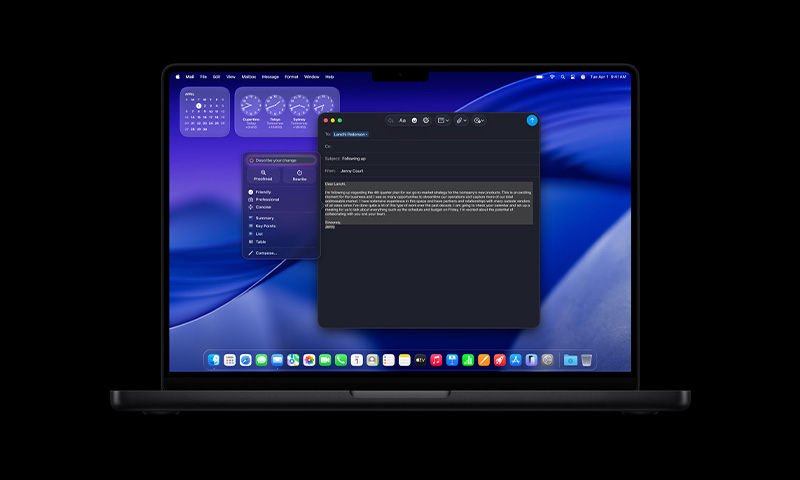- Web Desk
- 9 Hours ago
MacBook M5 Pro or M4 Air: which model is worth buying?
-
- Web Desk
- Oct 25, 2025

WEB DESK: Apple has rolled out the latest update to its MacBook lineup, introducing the new MacBook Pro powered by the M5 chip, only months after refreshing the MacBook Air with its M4 chip. The move marks another step in Apple’s push to redefine laptop performance, particularly in the growing field of AI-powered computing.
For those eyeing a new MacBook in 2025, the decision between the M4 MacBook Air and the M5 MacBook Pro has become more nuanced than ever. While the Air remains the go-to option for users who prioritise portability and affordability, the Pro now offers such significant hardware and performance upgrades that it could tempt even casual users to spend a bit more.
Design and display
At first glance, both machines share Apple’s signature minimal design, but the differences quickly become apparent. The MacBook Air continues to come in 13.6- and 15.3-inch models, featuring Liquid Retina displays with up to 500 nits of brightness. The Pro, on the other hand, sports a 14.2-inch Mini-LED Liquid Retina XDR display that can reach 1,600 nits peak brightness, offering deeper contrast and a smoother 120Hz refresh rate with ProMotion technology.
The Air’s thinner frame and lighter build remain its biggest advantages. The 13-inch version weighs just 1.24kg, while the 14-inch MacBook Pro comes in at 1.55kg. However, with the Pro’s additional ports, higher battery capacity, and active cooling system, the extra weight may be a fair trade-off for those who need more power on the go.
Performance leap
The star of Apple’s latest release is undoubtedly the M5 chip. Built on TSMC’s third-generation 3nm process, it promises faster and more efficient performance compared to the M4. Apple claims up to 15 percent faster CPU speeds, 30 percent faster overall graphics, and 45 percent faster ray tracing.
For AI-driven tasks, the M5 represents a substantial leap forward. It features integrated Neural Accelerators within every GPU core, enabling up to four times the peak GPU compute performance for AI applications. Apple also cites a 3.6× faster response in large language models and nearly double the speed in video enhancement and rendering workloads compared to the M4.
While these numbers sound impressive, the real-world advantage will be felt most by professionals who work in video editing, 3D design, or AI development. For everyday users performing basic productivity tasks, the M4 MacBook Air remains more than capable, offering performance that is nearly indistinguishable for light to moderate workloads.
Ports, battery, and build: the Pro difference
The MacBook Pro includes three Thunderbolt 4 ports, an HDMI 2.1 port, and an SDXC card slot—features notably absent from the Air. It also supports higher storage options of up to 4TB and a battery life of up to 24 hours, compared to the Air’s 18 hours. The new Pro’s active cooling system ensures sustained performance under heavy workloads, whereas the Air relies on passive cooling, which may throttle performance during extended use.
Audio and microphone quality also see a boost in the Pro, which includes a high-fidelity six-speaker system with force-cancelling woofers and a studio-quality mic array designed for professional recording and video conferencing.
Pricing and value: which one makes sense?
Apple has retained the same pricing for the Air lineup: $999 for the 13-inch and $1,199 for the 15-inch versions. The new MacBook Pro starts at $1,599, roughly $400 higher than the base Air.
However, the difference narrows at the top end. A 15-inch MacBook Air configured with 512GB of storage costs about $1,399, only $200 less than the entry-level 14-inch Pro. In that range, the Pro arguably offers better long-term value, thanks to its superior display, enhanced thermal design, longer battery life, and extra connectivity options.
The 2025 MacBook lineup shows Apple’s clear strategy: keep the Air as the mainstream choice for students, travellers, and casual users, while positioning the Pro as the powerhouse for creators and professionals.
Those seeking a sleek, lightweight laptop for daily tasks and entertainment will find the M4 MacBook Air more than sufficient. But for users who rely on performance-intensive applications or simply want a laptop that will remain fast and future-ready for years to come, the M5 MacBook Pro makes a compelling case.
Apple’s latest refresh proves that even as its laptops become thinner and lighter, the company’s ambitions for performance are only getting stronger.





